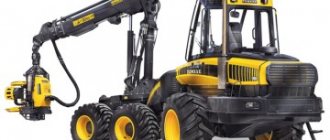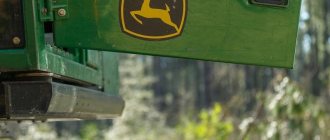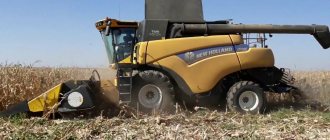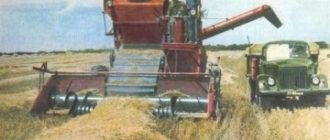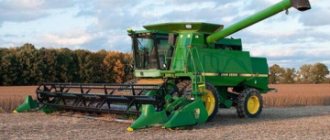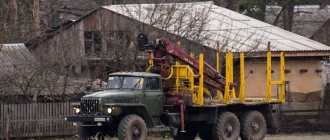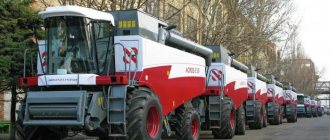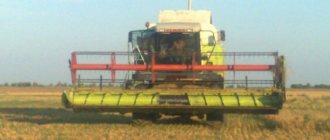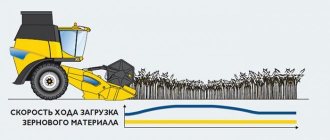Half a century ago, the profession of a lumberjack required great physical strength and endurance, and today, instead of lumberjacks and skidders, specialists with computer knowledge are increasingly required in logging operations. Technological progress has advanced so much that what was considered science fiction in the 70s and 80s has long become a reality. And this reality is that harvesters and forwarders today act as the main multi-purpose machines capable of performing the most complex tasks in logging.
History of the creation of the harvester
The harvesting combine, which is what the felling machine was originally called, was created as a working model in the USSR in 1984. Specialists from the Karelian Research Institute of Lesprom developed machines for felling trees and at the same time bucking them. The progress consisted in the fact that the main work of felling trees was performed by a unit equipped with a manipulator with a gripper on which saws were mounted. But this was the first machine of the logging complex. The productivity of the complex was significantly increased due to the second machine of the complex - a bucking combine. This felling complex processed wood in two stages - a felling machine carried out felling of the forest, and a second machine carried out bucking and cutting the trees to size. At the same time, logging with such a complex had one more element - the delivery of harvested material, usually carried out by a skidder.
A new stage in the development of technology was the invention of the harvester head, which made it possible to combine two machines into one unit - a harvester, or harvester. The innovation was that the action of felling wood and its initial processing was combined in one device - the saw head.
With the introduction of computer technology, harvester management has become easier; the harvester operator has the opportunity to control all processes. Starting from determining the volume of harvested wood and ending with determining the geolocation of production.
Since the appearance of the prototype, the principle of operation of the harvester has not changed, but has become significantly different thanks to new functions. The main action is now concentrated in one unit - a head with several saws. The crosscut saw is used for felling trees and cutting according to the assortment, other saws are used for removing branches and twigs. The tracked harvester was eventually replaced by a machine with a more versatile wheeled platform.
What a modern harvester is was introduced in 1996 by John Deere - it was he who released a machine that can be called the first modern harvester.
The development of this type of technology led to the emergence of several types of such machines. The mini version can be seen not only in the forest; this type of equipment has also been used in Moscow. These machines are indispensable in the forest and park areas of the capital. As for transportation, the heavy crawler tractor has been replaced by the concept of a forwarder - a wheeled tractor with a manipulator and a body for transporting wood.
Technical characteristics and operating features of John Deere 1270, 1470 harvesters
Model 1270, the first version of which was released back in 1996, has become a standard of quality and a role model. Today, the 1270 E equipment is considered the most powerful, and there is no doubt about its performance. They are designed to handle the largest and most complex logging jobs, but at the same time cope well with the final thinning process.
The weight of John Deere 1270 harvesters is 18.4 tons. The harvester has a powerful 6-cylinder engine with 228 hp and a volume of 9 liters. The improved CH7 manipulator has a maximum boom reach of 8.6 / 10, 11.7 m. The boom rotation angle is 220⁰. The hydraulic system is load controlled. The transmission is equipped with a differential lock on the rear and front axles.
There are two cabin options: fixed and rotating with leveling capabilities. The cabin has a low level of noise and vibration, and is also equipped with air conditioning and other options that make the operator’s work more comfortable. The cost of used 1270 D models ranges from 5 to 7 million rubles.
The 1470 E equipment is a powerful machine weighing 20 tons and having a tractive effort of 180 kN. These John Deere harvesters have a 9-liter turbocharged engine with intercooling. The boom length is 8.6 / 10, 11 m. Harvesters of this model have increased stability and maneuverability.
Design and principle of operation of the combine
Manufacturers of harvesters most often use a turning point machine layout. Most models do not have a solid chassis frame, with the exception of tracked models. The harvester device consists of the following parts and assemblies:
- breaking chassis;
- diesel engine;
- control system;
- hydraulic system;
- electrical equipment;
- transmission;
- manipulator;
- harvester heads.
Harvester - a self-propelled forestry combine has a powerful 6 or 8 cylinder diesel engine as an engine. The engine power ensures the operation of the electrical equipment and hydraulic system of the machine. The hydraulic system ensures the fulfillment of the main functions of the manipulator - removal of the working element, capture and retention of sawn wood, layout of sawn wood. Hydraulics also operate the braking system and tilt the operator's cab. Electrical equipment ensures the operability of the control system. The transmission ensures the movement of the vehicle, including over rough terrain.
A separate element is a manipulator with a working element - the harvester head; it ensures that the felling head is brought to the tree, the trunk is captured and held, and the processed part is moved to the storage location.
Harvester heads include several mechanisms:
- felling and bucking mechanism;
- broaching mechanism;
- mechanism for cutting branches and branches.
These mechanisms have hydraulic drives for saw blades and a chain mechanism, movable delimbing knives and a cross-section chain saw, four-roll broaching and brake mechanisms.
Work principles
The operating principle of the harvester is based on a comprehensive solution of problems in conditions of continuous or selective felling of forests. A machine designed for felling provides a number of other related tasks:
- bucking;
- limb pruning;
- assortment layout;
The performance of the machine depends on the modification - the most powerful ones have chain saws with a bar length of 750 mm and are used for logging in the taiga. This type of mini harvester is designed for pruning branches and thinning trees in forested areas; this technique works mainly in young plantations, where trees have trunks up to 40 cm in diameter.
The general scheme of operation of a forest harvester is as follows:
- The harvester operator, using navigation, drives the machine to the logging site;
- The computer parameters specify the assortment of harvested wood;
- The machine is driven to the tree and the manipulator is deployed;
- The operator brings the felling unit to the tree at the base and makes a grip;
- The chain saw cuts down the trunk, after which the manipulator places the tree on the ground;
- The broaching device pulls the trunk, parallel pruning knives cut off branches and twigs;
- Having reached the specified length of the segment, the saw makes a cut;
- The resulting segment is stacked by the manipulator for loading onto the forwarder.
Advantages and disadvantages of harvesters
As with most types of highly specialized equipment, harvesters have both positive aspects and disadvantages. The advantages include:
- Harvester can work in different climatic and weather conditions, in complex terrain;
- The machine is used as a logging complex for continuous felling of forests, thinning and sanitary felling;
- With the use of a harvester, production standards are increased, the amount of waste is reduced, and the volume of felling and product mix are analyzed;
- Labor productivity increases.
On the other hand, the disadvantages include:
- The need for special training for the harvester operator;
- The machine is used in conjunction with a vehicle, so the purchase of a forwarder is necessary;
- The machine works perfectly in the forest on the plain, and on small slopes; for large angles of inclination, it is dangerous for most machines to work;
- During industrial harvesting, not all types of machines can cope with large tree diameters. Crosscut saws have a maximum length of 75 cm.
Types of harvesting combines
The classification of combines today is done mainly according to the purpose of the machine and the possibilities of its use. Based on the description and design of the machines, the following types of harvesters can be distinguished:
- lightweight type of machine - designed for work in forested areas of cities, the main purpose is cutting branches and trees with a diameter of 50 to 400 mm
- medium machines – a universal type of machine for felling trees with a diameter of 500 mm.
- heavy harvester – performs the main work of industrial felling in clear-cut areas;
- super-heavy harvesters - used as the main working equipment in relict forests, where it is necessary to capture trunks of 1 meter or more.
Specifications
You can imagine what a harvester is by studying the technical characteristics of the John Deere 1270D.
Technical characteristics of John Deere 1270D
| engine | Diesel, 6 cylinder, 9 liters |
| Engine power | 160 kW |
| Maximum torque | 1100 Nm |
| total weight | 17.4 t |
| Fuel tank volume | 480.7 l |
| Hydraulic system volume | 290 l |
| Voltage | 24 V |
| Maximum speed | 24.9 km/h |
| Ground clearance | 624 mm |
| Maximum boom range | 9.3 meters |
| Maximum forward tilt | 11° |
| Lateral tilt | 15° |
| Height | 3.7 m |
| Width | 2.7 m |
| Wheelbase | 4.0 m |
| Cross saw bar length | 750 mm |
| Chain pitch | 10 mm |
| Maximum cutting diameter of tree trunk | 56 cm |
| The force of pulling a tree trunk through the head | 22-27 kN |
| Feed speed | Max 4.7 m/s |
| Number of delimbing knives heads | 4 |
| Diameter of full trunk coverage in the delimbing area | 48 cm |
| Measuring wheel error | 0.1 mm |
John Deere 1270D harvester design
Design of the John Deere 1270D harvester
The weight of the John Deere 1270 harvesters is 18.4 tons. The harvester has a powerful 6-cylinder engine with 228 hp and a volume of 9 liters. The improved CH7 manipulator has a maximum boom reach of 8.6 / 10, 11.7 m. The boom rotation angle is 220⁰. The hydraulic system is load controlled. The transmission is equipped with a differential lock on the rear and front axles.
There are two cabin options: fixed and rotating with leveling capabilities. The cabin has a low level of noise and vibration, and is also equipped with air conditioning and other options that make the operator’s work more comfortable.
Operator's cabin
Spacious, bright, comfortable with an ergonomic seat, equipped with easy-to-use mini-joystick controls. Equipped with efficient heating and air conditioning. Provides good visibility of the working area and good working conditions for the operator. The cab is safety tested according to ISO industry standards (ROPS, FOPS, OPS, BC).
The noise level in the cabin meets international standards. The cabin is equipped with a radio tape recorder, has tinted glass made of impact-resistant material and a socket for connecting a cell phone. As an additional equipment, the John Deere 1270D harvester is equipped with an automatic cabin leveling and rotation system, which increases the level of ergonomics and reduces the likelihood of damage to the cabin by trees that remain during selective felling.
Engine
John Deere JD 6081 HTJ D3 turbocharged diesel, six-cylinder, cylinder displacement 8.1 l, maximum power 160 kW at 2000 rpm, torque 1100 Nm at 1400 rpm, capacity fuel tank 480 l.
The engine torque makes it possible to simultaneously turn on the harvester head pulling motors and use the hydraulic manipulator functions, which allows you to increase the productivity of the harvester. Under operating conditions, the engine can be used at lower crankshaft speeds, which leads to lower fuel consumption, longer crank life and lower noise levels.
Transmission
Transmission John Deere 1270D
Hydrostatic-mechanical with dual-range transfer case. Travel speed V = 0…24 km/h, maximum traction force Pk = 160 kN. The transmission includes a hydraulic pump and motor, a two-stage transfer case (high and low gears), and driveshafts. The hydrostatic transmission element includes a hydraulic pump and a hydraulic motor, which are connected to each other by a suction and discharge circuit.
Hydraulic pump and piston-type engine - with adjustable working volumes. The working volume of the hydraulic pump is in the range of 0...100 cm3, the engine - 140...160 cm3. When starting, the hydraulic motor always has maximum displacement. The transfer case distributes torque from the hydraulic motor between the front and rear axles. It is a mechanical gear transmission and provides high and low gear ranges, and also allows you to disable the drive to the front axle.
Hydraulic system
Constant pressure, load sensitive, operating pressure – 24…28 MPa. The pump capacity is 288 l/min at a rotation speed of 1800 rpm of the hydraulic pump shaft. The harvester hydraulic system includes:
- engine hydraulic pump;
- hydraulic distributor HV09 for manipulator movement;
- hydraulic motor;
- pressure accumulators;
- hydraulic valves;
- brakes, etc.
Brake system
Hydraulic. The service and service (auxiliary) brakes are multi-disc in an oil bath with a hydraulic drive. The front axle is equipped with service brakes in front of the differential. When processing wood, to ensure equal force on all wheels, the differential lock is activated simultaneously with the brakes. The service brakes of the rear axle are mounted on the hubs. The parking brake is mounted in front of the rear axle housing and has a mechanical spring engagement and hydraulic release.
Steering
Stepless with electric drive, carried out using a manual “joystick” manipulator by turning the articulated semi-frames with two hydraulic cylinders. The angle of rotation of the semi-frames is ±42º.
Hydraulic manipulator
With parallel boom models TJ 210H90, 210H97, 210H115 with maximum boom reach (with head) 9.3; 10 and 11.8 m and a lifting moment (gross) of 178 kNm. Boom rotation angle – 220º, hydraulic manipulator rack tilt angle – 25º forward and 13º back/
Electrical equipment
Generator 288 V/140 A; two rechargeable batteries of 140 A each and a voltage of 24 V. 14 double work lights and four single ones are installed on a hydraulic manipulator with illumination in the work area at night of at least 30 lux.
Harvester (processor) heads
A wide selection of harvester heads allows the John Deere 1270D harvester to be used in a variety of conditions. The powerful H762 and 758 heads are designed for use in final cuttings, while the H754, 745 and H752D heads are designed for use in thinnings. Harvester heads 758, H754 and 745 allow you to work with trees that have twisted trunks with thick branches.
The head is equipped with four movable delimbing knives, a powerful four-roller drive, hydraulic brakes, and a chain saw mechanism with a hydrostatic drive.
Mechanism for felling and bucking the harvester head
Includes hydrostatically driven chain saw. The length of the saw bar is 750 mm, the pitch of the saw chain is 10 mm, the speed of the saw chain is 40 m/s, the recommended productivity of the harvester hydraulic pump is 250 l/min at an operating pressure in the system of 24 MPa. The maximum diameter of a tree cut (for one cutting step) is 56 cm.
Wood pulling mechanism
It includes four hydraulic motors that work together and drive two frame-mounted and two movable drawing rollers. Pulling force – 22.0…27.0 kN. The wood drawing speed is 4.7 m/s, the maximum opening of the drawing rollers is 70 cm.
Harvester head delimbing mechanism
Includes four movable delimbing knives with hydraulic drive. The diameter of the tree trunk in the delimbing zone, covered 100% by the delimbing knives, is 48 cm. A dual potentiometer located above the delimbing knives and a measuring wheel pressed against the tree trunk accurately measure its diameter and length.
Harvester control
The harvester control center is located in the cabin - this is the operator’s workplace. This place provides control of the harvester; the cabin is equipped with everything necessary for work, from joysticks (many machines do not have a regular steering wheel) to monitors that transmit data from the harvester head and video cameras mounted on the boom.
The cabin is made of high-strength metal and has large glazing - the operator has the opportunity to control all processes without leaving the cabin. In addition, the cab itself has an autonomous leveling mechanism, so the operator does not experience heavy workload.
The operator directly controls the logging process using several joystick manipulators - levers and steering wheels are not provided in the cabin. But there is air conditioning, a radio, a radio, a radio station and a charger for a mobile phone. The windows are tinted, and the chair looks more like a car seat than a workplace. Additional visibility occurs due to cameras transmitting images to monitors.
Control of the assortment, quantity and quality of harvested wood during operation of the harvester head is immediately transferred to the central computer. When sanitary cutting and thinning of tracts, the computer itself records the felling sites, on the basis of which a map of industrial plantings is compiled.
The processed wood is stored in stacks, while the computer records the location of the stack, calculates its volume and transmits the necessary information to the forwarder’s computer.
Popular harvester models
Harvester manufacturers offer different types of machines in their model line. But one of the most popular remains multi-purpose heavy machines for industrial logging.
A distinctive feature of the John Deere model 1270D harvester is that the combine is equipped with modern computer equipment. The large weight of the machine, all-wheel drive and a powerful diesel engine make this harvester one of the best in its class. It is designed for clear-cutting forests with a head gripping diameter of 56 cm. The model can be equipped with a manipulator length of 8.6, 10 and 11.7 meters. The rotation angle is 220 degrees.
Komatsu 941.1 from the Japanese concern Komatsu is considered one of the largest harvesters. The advantages of the machine include high maneuverability and reliability. The operator's cabin has an automatic stabilization function. The possibility of circular rotation of the cabin and boom with a manipulator also facilitates work. The car has a significant weight - 23.5 tons. The boom reach (depending on the model configuration) is 8 or 10 meters.
The American-made Cat 521B harvester is characterized by high productivity, excellent maneuverability and reliability. Like all Caterpillar machines, it is equipped with a powerful, yet economical diesel engine. The cabin has an independent leveling system. The weight of the vehicle is one of the largest - 27 tons. The maximum reach of the working head is 9.9 meters. The transmission and chassis provide confident movement both in swampy terrain and on rocky areas. As you can see, technological progress does not stand still. Modern forestry machines have almost reached their perfection, replacing humans in most production operations. But even here it is too early to draw an end to the history of the development of logging mechanization. After all, the use of new computer technologies in harvester equipment is only the beginning of its widespread implementation in forestry.
John Deere harvesters: main characteristics of models 1070 E, 1170 E
The John Deere 1070 E and 1170 E harvester models are universal machines that are widely used in both final felling and partial forest thinning. Depending on the nature of the operations being performed, the configuration of the equipment can be changed - for this, several head options and different lengths of the manipulator boom are provided.
Thus, the John Deere 1070 E harvester is the optimal choice for working in areas that require careful felling. Thanks to its high maneuverability, the machine is able to move among densely growing trees, while the pressure on the soil is as gentle as possible. This model is available in two versions: 4-wheel and 6-wheel.
The power of the installed 6-cylinder diesel engine is 182 hp. Fuel tank capacity - 320 l. The frame is rotated using joysticks, the rotation angle is 44⁰.
Model 1170 E has similar characteristics with a more powerful engine (194 hp). In general, this John Deere harvester is a representative of a new size class of logging machines and is distinguished by its impressive load capacity and high traction force.
The maximum boom reach of the 180 S (in the 1070 E model) is 8.6 / 10 / 10.8 m, the rotation angle is 220⁰. The CH6 manipulator (in the 1170 E model) has a maximum reach of 10 / 11.3 m. Harvesters are equipped with a fixed or rotating cabin with leveling functions. The cost of these used harvester models starts from 3 million rubles.
